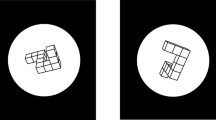Abstract
Many scientific discoveries have depended on external diagrams or visualizations. Many scientists also report to use an internal mental representation or mental imagery to help them solve problems and reason. How do scientists connect these internal and external representations? We examined working scientists as they worked on external scientific visualizations. We coded the number and type of spatial transformations (mental operations that scientists used on internal or external representations or images) and found that there were a very large number of comparisons, either between different visualizations or between a visualization and the scientists’ internal mental representation. We found that when scientists compared visualization to visualization, the comparisons were based primarily on features. However, when scientists compared a visualization to their mental representation, they were attempting to align the two representations. We suggest that this alignment process is how scientists connect internal and external representations.
Similar content being viewed by others
References
K. Dunbar (1997) How Scientists Think: On-Line Creativity and Conceptual Change in Science T.B. Ward S.M. Smith (Eds) Creative Thought: An Investigation of Conceptual Structures and Processes American Psychological Association Washington, DC, USA 461–493
K.A. Ericsson H.A. Simon (1993) Protocol Analysis: Verbal Reports as Data EditionNumber2 MIT Press Cambridge, MA
A. Findlay (1948) A hundred years of Chemistry Duck-worth London
D. Gentner (1983) ArticleTitleStructure Mapping: A Theoretical Framework for Analogy Cognitive Science 7 155–170 Occurrence Handle10.1016/S0364-0213(83)80009-3
D. Gentner (1989) The Mechanisms of Analogical Learning S. Vosniadou A. Ortony (Eds) Similarity and Analogical Reasoning Cambridge University Press New York, NY
D. Gentner S. Brem R.W. Ferguson A.B. Markman B.B. Levidow P. Wolff K.D. Forbus (1997) ArticleTitleAnalogical Reasoning and Conceptual Change: A Case Study of Johannes Kepler Journal of the Learning Sciences 6 IssueID1 3–40 Occurrence Handle10.1207/s15327809jls0601_2
J. Hadamard (1945) The Psychology of Invention in the Mathematical Field Princeton University Press Princeton, NJ
M. Hegarty (1992) ArticleTitleMental Animation: Inferring Motion from Static Displays of Mechanical Systems Journal of Experimental Psychology: Learning, Memory and Cognition 18 IssueID5 1084–1102 Occurrence Handle10.1037/0278-7393.18.5.1084
C.A. Kaplan H.A. Simon (1990) ArticleTitleIn Search of Insight Cognitive Psychology 22 374–419 Occurrence Handle10.1016/0010-0285(90)90008-R
S.M. Kosslyn K.E. Sukel B.M. Bly (1999) ArticleTitleSquinting with the Mind’s Eye: Effects of Stimulus Resolution on Imaginal and Perceptual Comparisons. Memory and Cognition 27 IssueID2 276–287
N.J. Nersessian (1999) Model-Based Reasoning in Conceptual Change L. Magnani N.J. Nersessian P. Thagard (Eds) Model-Based Reasoning in Scientific Discovery Kluwer Academic/Plenum Publishers New York 5–22
J.R. Newman (1955) ArticleTitleJames Clark Maxwell Scientific American 192 IssueID6 58–71 Occurrence Handle10.1038/scientificamerican0655-58
R. Shepard (1988) The Imagination of the Scientist K. Egan D. Nadaner (Eds) Imagination and Education Teachers College Press New York/London 153–185
R. Shepard J. Metzler (1971) ArticleTitleMental Rotation of Three-Dimensional Objects. Science 171 701–703
N.J.T. Thomas (1999) ArticleTitleAre theories of Imagery Theories of Imagination? Cognitive Science 23 IssueID2 207–245 Occurrence Handle10.1016/S0364-0213(99)00004-X
J.G. Trafton S.S. Kirschenbaum T.L. Tsui R.T. Miyamoto J.A. Ballas P.D. Raymond (2000) ArticleTitleTurning Pictures into Numbers: Extracting and Generating Information from Complex Visualizations International Journal of Human Computer Studies 53 IssueID5 827–850
Trafton, J.G. and S.B. Trickett: 2001, A New Model of Graph and Visualization Usage. In The Proceedings of the 23rd Annual Conference of the Cognitive Science Society. Mahwah, NJ: Erlbaum.
Trickett, S.B., W.-T. Fu, C.D. Schunn and J.G. Trafton: 2000, From Dipsy- Doodles to Streaming Motions: Changes in Representation in the Analysis of Visual Scientific Data. Proceedings of the 22nd Annual Conference of the Cognitive Science Society. Mahwah, NJ: Erlbaum.
Trickett, S.B., J.G. Trafton, C.D. Schunn, and A. Harrison: 2001, That’s Odd! How Scientists Respond to Anomalous Data. Proceedings of the 23rd Annual Conference of the Cognitive Science Society. Mahwah, NJ: Erlbaum.
R.D. Tweney (1992) Inventing the Field: Michael Faraday and the Creative “Engineering” of Electromagnetic Field Theory R.J. Weber D.N. Perkins (Eds) Inventive minds: Creativity in Technology Oxford University Press New York, NY, USA 31–47
J.D. Watson (1968) The Double Helix New American Library New York
Author information
Authors and Affiliations
Corresponding author
Rights and permissions
About this article
Cite this article
Trafton, J.G., Trickett, S.B. & Mintz, F.E. Connecting Internal and External Representations: Spatial Transformations of Scientific Visualizations. Found Sci 10, 89–106 (2005). https://doi.org/10.1007/s10699-005-3007-4
Issue Date:
DOI: https://doi.org/10.1007/s10699-005-3007-4




